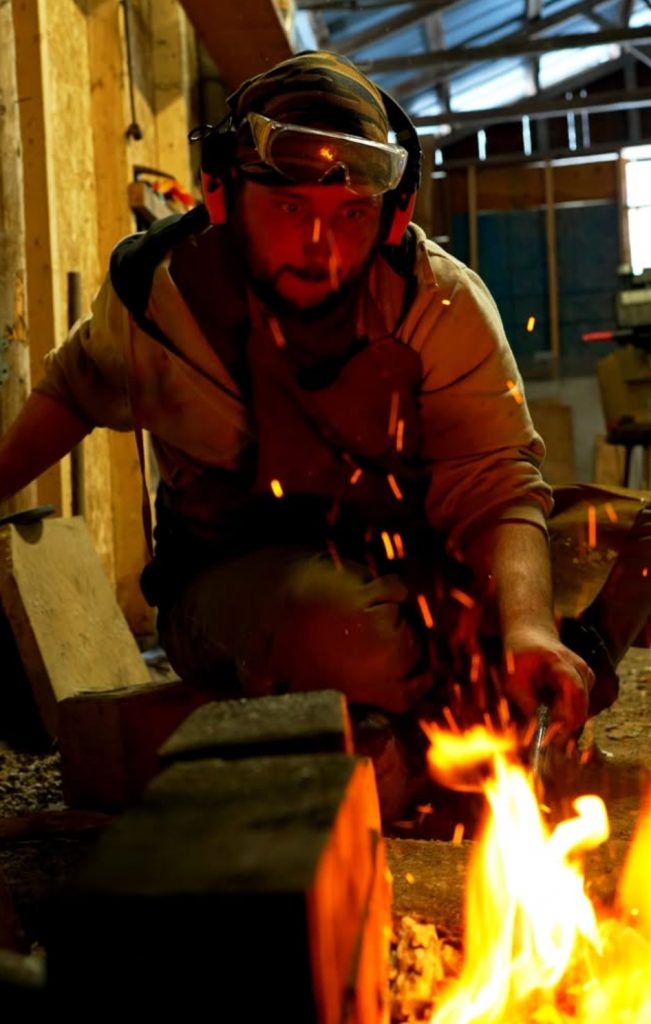
photo credit : Shogo
This week’s interview takes us back to Canada and gives me the opportunity to introduce you all to Steve Cornelsen. His enthusiasm for the craft of Japanese knife making is infectious. I truly enjoy how he recontextualizes the traditional through his lens. Passion is so important to art, to a certain extent it is the fuel that keeps us going. And I absolutely love interacting with passionate people like Steve.
To start off, please tell us a little about yourself.
My name is Steve and I am a blacksmith / bladesmith from Caledon, Ontario, Canada.
I started blacksmithing at the age of 15, which took me through quite the tour of all the different disciplines that reside within the craft. Armour making was my first stop, which turned into tool making, onward to axe making and that served as the stepping stone into bladesmithing which really pulled me in. To call it an obsession would be a bit of an understatement…It consumes me.
I was a bit of a nomad in my early adulthood. I spent most of my adult life traveling and teaching in China. It was quite difficult to own a forge where I was residing, so I did take a bit of a hiatus from that. I’ve been back in Canada since 2017, rebuilt my shop and have been gradually adding to it, and have been back at forging ever since.
What sparked your interest in knives?
The Japanese discipline of knives had always caught my eye. I’ve found myself impressed by what their geometries combined with finely sharpened edges are capable of. I am completely mesmerized by honyaki blades and their hamons, which is probably why I like to include honyaki in my collections.
I also knew a lot of knife makers in the Canadian blacksmith community and was always impressed by their work, not just the blade itself but their handle work, fit and finish, all these small intricacies that went into their builds. It lit a fire.
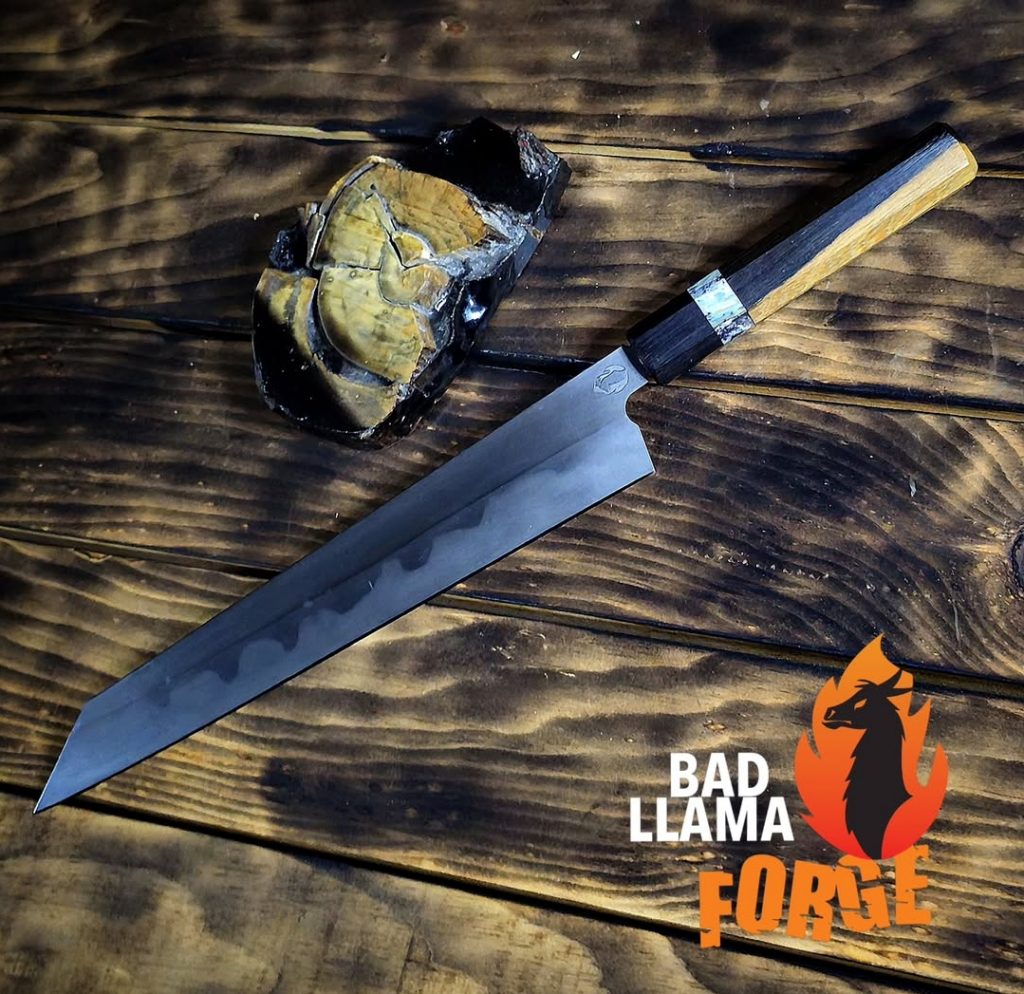
What inspired you to do this and how did you learn?
A few good blacksmith / bladesmith friends do some absolutely stunning work. Watching them make, test and show out…it lit a fire, they suggested I take the plunge, try it out…see where it takes me.
Learning certainly was not easy. New skill sets needed developing, new understandings needed studying, and a lot of botched projects turned lessons needed to happen before I could harness the consistency and results that I am able to produce now.
To say that I am completely self-taught would just not be true, granted I did learn a lot of lessons on my own through experimentation, books, and the internet.
However, I did also have some great makers in my corner who were both willing to give me some great advice and lessons but also, they were willing to be brutally honest with their feedback; to which I feel was essential for development as a maker.
I also took almost half a month study vacation to learn with Rick Marschand of Wilder Tools.
This experience was a pivotal moment for me as a maker.
When did you start making knives?
I started going at it making what I would call a ‘real’ knife once I moved back to Canada and finished rebuilding my shop in 2018. I’ve been making knives ever since.
I did make a couple knife shaped objects when I first started at 15…but to call them a knife, would be a stretch.
When I first built my forge, I had very ambitious katana shaped goals which quickly reshaped into long-term future goals once reality had sunk in and I had realized exactly how much work that was going to be.
What did you make your first knife with?
My first ‘official’ knife taken from start to finish would be one I made in 2018.
At that time I had no 2×72 in the shop, or bought knife steels for that matter. I used what I could get my hands on which was a leaf spring that I presumed to be either 5160…right or wrong it hardened up fine…that was good enough for the project.
I threw some curly maple for the handle, brass pin stock and, yes you guessed it: I burnt the wood around the pins when shaping the handle.
On paper it’s nothing special, it’s the first knife I had taken to the finish line. So, to me it is special and a keepsake, I’ll always remember that one.
Do you have a favorite knife you made, tell me about it?
Oh, that is a hard one to answer…
I think I have to call out a batch of Honyaki blades that produced two gyutos and a bunka. The latter I traded for my first tattoo work. The hamon was not exactly anything wild or crazy, in fact some may call it a bit on the tame side.
I do, however, think there can be an element of beauty in simplicity. In this case I stand by that.
Ancient bog oak handle with a mammoth tusk accent, 26c3 steel sitting at 64 HRC.
What is the most important aspect of a well-made knife?
Assuming that all other variables are on point:
It’s my opinion that the heat treatment and understanding what’s happening to the steel during said treatment can make or break a knife.
A good steel for the job, properly heat treated will perform great.
The same steel improperly heat treated can still obtain hardness but not live up to its full potential, or even worse cause vulnerabilities in the blade itself, such as grain growth or worse.
Furthermore, I would add the obvious: that the heat treatment should definitely be adjusted to match the intended purpose of the knife.
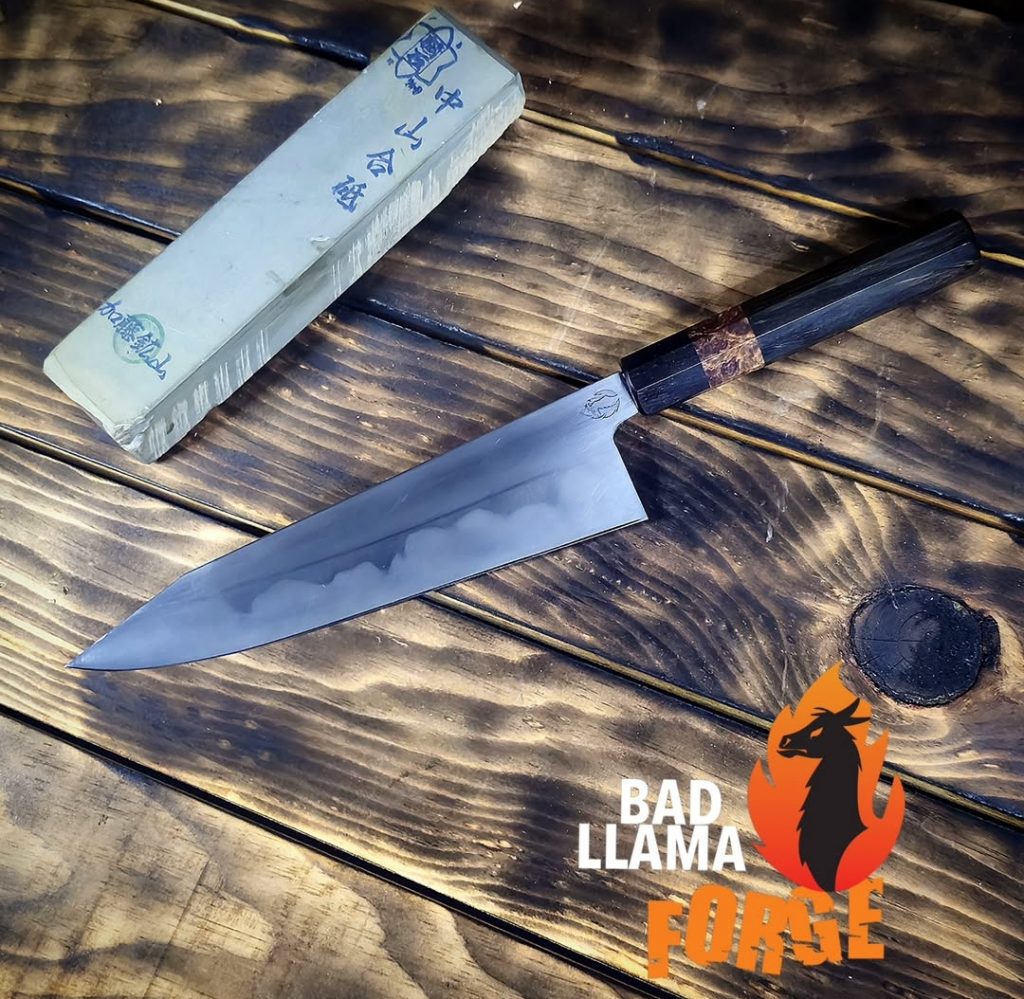
What keeps you going?
My wife who is my #1 supporter and promoter.
My family, friends, those who own / collect my work, who support me, and push me forward.
Having such a strong foundation of good people around me and my work who want me to succeed…to keep improving.
It’s moving and it lights a strong fire.
At the risk of sounding corny: both my failures and success drive me.
I revel in personal victories: when breaching milestones, or each satisfied customer for example.
Also, accepting and taking the loss when I fail, look within for a lesson and adapt.
Every failure has the potential to be turned into success; if you look and analyze to understand what went wrong and why.
Looking back at old projects a year old or first knife even. It’s a humble reminder of where you were at that time and where you are now. Seeing your progression and your style’s evolution.
Biggest struggle?
A healthy balance of time, especially when there is a knife show 45 days down the road and you haven’t hit your stock goal yet…that sounds a bit too specific to be an example.
On a personal level with a full que and busy work schedule, finding time to pursue personal projects for myself can be a bit of a struggle.
Keeping inventory up, making three Futokoro-gatana for groomsmen and organizing a wedding…that was a bit of a struggle too.
In all instances perseverance will yield results.
What kinds of knives do you make?
I would say that most of my workpieces are Japanese inspired carbon steel kitchen knives.
Using exotic wood and materials for a wa handle.
However, if I have the time, I’ll do something outside of my usual.
I have a couple projects on my table just waiting for some free time. (HAH!)
How did your background affect your approach to knives?
Professionally…not at all.
I’m a former English teacher turned Axe throwing coach, who also wants to sell knives.
My love of cooking has definitely been a helping hand.
That being said, I am by no means a professional cook. I simply do a lot of cooking at home and when guests are over. Cooking over the years and having quite a few friends in the industry has given me some very helpful insight into what I do.
I would have to say that the only time my background does come into play is when I run a class in my shop. Teacher mode switches on, just like muscle memory.
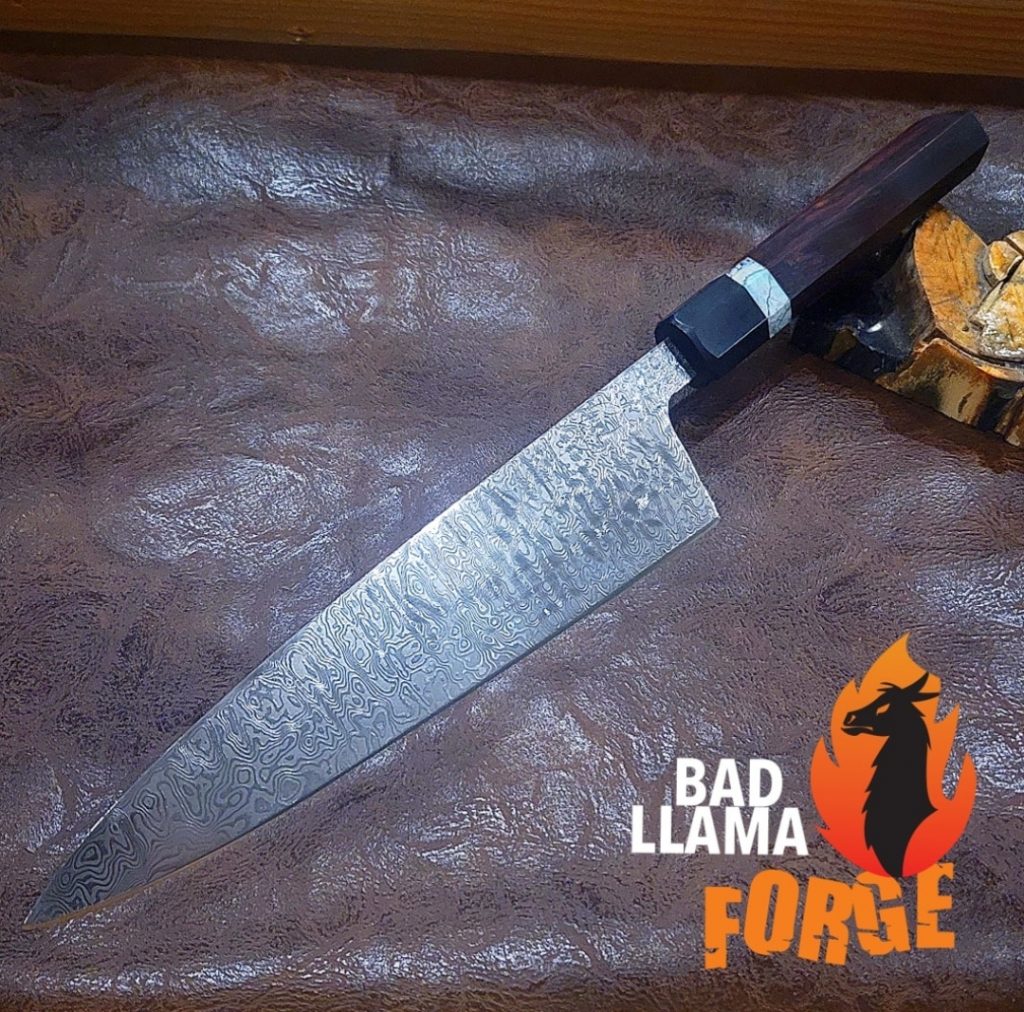
Who helped you early on?
There have been a few who have been there to guide me in the early days.
Most notable, being:
Brad Millman – Taught me the do’s and don’ts of knives and making damascus steel. Gave me unfiltered advice, even if it was hard to hear at times. It was something I needed to hear.
Rick Marschand – Taught me knifemaking, the science behind heat treating and reshaped my fundamental understanding of knife making. Helped me eliminate old bad habits.
Darcy Quapp – Gave me advice, pushed me to try things outside of my comfort zone. Taught me some very interesting techniques that he employs.
Who are your influences?
Most of my influences are those who helped me out early on. I have been lucky enough to be in contact and guided by those whose work had inspired me to pursue the craft.
In 2021 I was gifted a book showcasing Japanese kitchen knives and their makers of 2020 Nippon no Hocho 日本の庖丁. I was absolutely taken in with the designs, work, and profiles. I already had a heavy interest in Japanese knives at that time, but this series of books really drove that nail home, now I’ve always got my eyes peeled for other volumes. I think that some of the featured knives in this book are responsible for making me fall in love with the K tip.
What other knife makers out there impress you these days? Do you take inspiration from anyone else in the field?
There are so many knife makers out there that do such fantastic work, and I can’t wait to find more, a few names that come to mind right off the top:
Rick Marschand, Brad Millman, Dracy Quapp, Milan Gravier, Dave Friesen, Chris Green and his apprentice- Hudson Torrens. I’m excited to see what the future holds for everyone’s work.
(there are so many more makers that blow me away)
I try to approach taking inspiration rather carefully.
I try to capture the passion, love for the craft, and the creativity that they put into their own work, use that to light a fire that fuels the passion for my own work.
I feel that it’s important to leave it at that.
Applying another maker’s very unique creative elements to your own work I find can hinder your own styles natural evolution, It’s important as a maker for your own work to reflect you and your own creativity. It’s what makes us makers so unique and diverse from one another. There are so many makers out there that I don’t even need to look at the name or logo. I know from their work alone. I feel when a maker has achieved that – Instant recognition… that’s a huge milestone and a credit to their personal evolution.
Any specific breakthroughs or revelations in your knife making journey?
There have been many. Some of which came to light during my ‘knife pilgramage’ across certain parts of Japan. Meeting makers and talking about their work, methodology, and just talking shop. Which is how I came into possession of my current hamon clay recipe and the design for my Japanese sword forge.
I would also say that to me; having my knives on retail shelves at Tosho Knife Arts in Toronto is quite the breakthrough, and (at the risk of tooting my own horn) the result of hard work paying off.
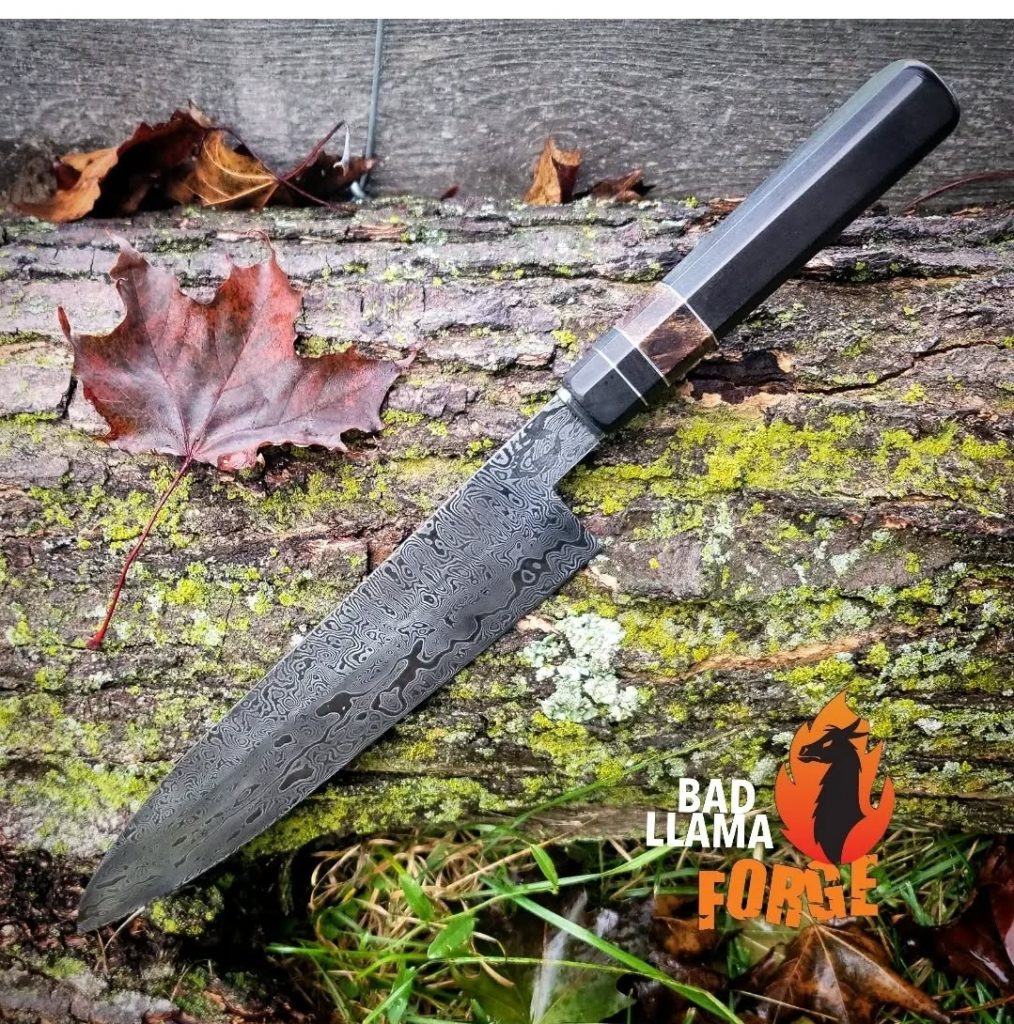
What is the perfect knife?
A perfect knife for me would be a knife that is optimized for the task at hand. There is no, be all end all of knives, while there are general purpose that can do a multitude of tasks quite well, but if you want a knife to perform exceptionally well at something, it needs to be well thought out and designed for dealing with that task.
If it is my choice, I would choose to name the knife that inspired me towards Japanese knives in the first place: The Sakimaru…but that is purely based on personal preference.
How do you approach knife testing?
It really depends on what kind of knife it is and its intended function. I like to give the knife some stress tests, see how it feels when cutting through different types of food with the geometry alone, then with a basic edge, I’ll then dull the edge, take it to final polishing and give it its final edge.
For something like an EDC or outdoor knife is when I get into more stressful durability tests.
How do you develop a design, select a steel, and fine-tune a heat treatment?
Most designs of mine have a beginning….a model zero.
That they evolve from through new versions that may slightly change the geometry, profile, or even heat treatment.
I go through trials alongside individuals who are either enthusiasts or have been in the industry.
We gather the likes, dislikes and move on from there. The result is a series of evolving designs with the goal to either be equal to or surpass the last batch.
Bonus points if a chef smiles or says “oh my” on the first cut.
Selecting a steel all comes down to what I am expecting out of the knife.
Most of my applications are kitchen knives, usually san mai or honyaki, so for me that would call for a steel that has a higher hardness capability, has the ability to take on some nice hamon activity and hold a very fine edge. On the other hand, sometimes I need to pull out the really tough stuff with more corrosion resistance. This is typically the case when I make something along the lines of an EDC or outdoor knife.
What are your favorite steels, and what do you like about them?
For my regular work I am particularly fond of 125CR1 and 26C3:
I am able to get a high hardness and high reliability out of them, they can take a great hamon and the final edge you can get is very satisfying indeed!
That being said I also stand by the 10XX series steels
When it comes to any steel: It’s a two way street, having an intimate understanding of their capabilities and heat treatment can yield some great results.
When I accept a custom job I usually have an interview with the customer to see what they are wanting out of the knife. That usually gives me more than enough information to go on to select a steel from a list of steels I stock that I feel would satisfy the new owner.
How has the knife world changed since you started?
Availability of information on the internet for one. When I was 15, YouTube was non-existent, at least to me.
56k modem, was the fastest internet I’ve ever had until I moved to China and had my expectations blown away with MB/s speeds…
From 2018 to now, I would definitely say there are a lot more products out there geared towards knife makers, better/more specific tools, and a wider range of good steels.
Also, the addition of knife maker suppliers such as Maritime Knife Supply being available.
Makes sourcing things a whole lot easier.
What’s up next for you? Any exciting new projects to tell us about?
Oh, I have some interesting projects in the works,
I am sending a knife off to get video reviewed, so I’m looking forward to that.
I am also in mid process of an ongoing project that is a Wakizashi – the goal is to make things as traditional as possible. Heat treatment in the traditional charcoal Japanese sword forge, carved saya and tsuka, traditionally made habaki. I am hoping I get to finish it in the coming months, though I am in no rush. I want to take my time with it and have it be an enjoyable process rather than feeling like I need to rush to finish it.
After the success trials of the Futokoro-Gatana for my groomsmen at my wedding, I plan on making a couple more to put on the shelf at Tosho Knife Arts.
To see more of Steve’s work and keep up to date on what he has going on, check out his website http://www.badllamaforge.com , or visit his Instagram https://www.instagram.com/bad_llama_forge/
Leave a Reply